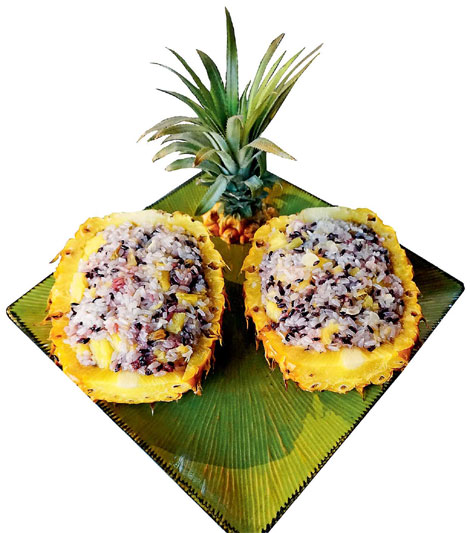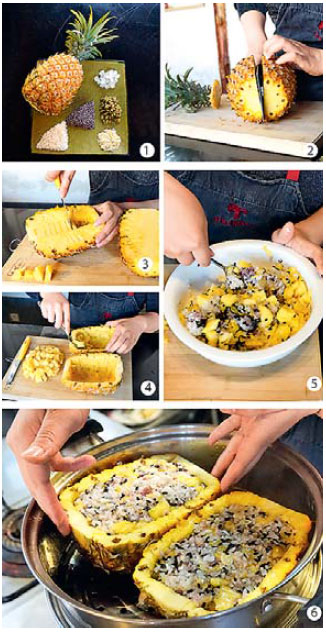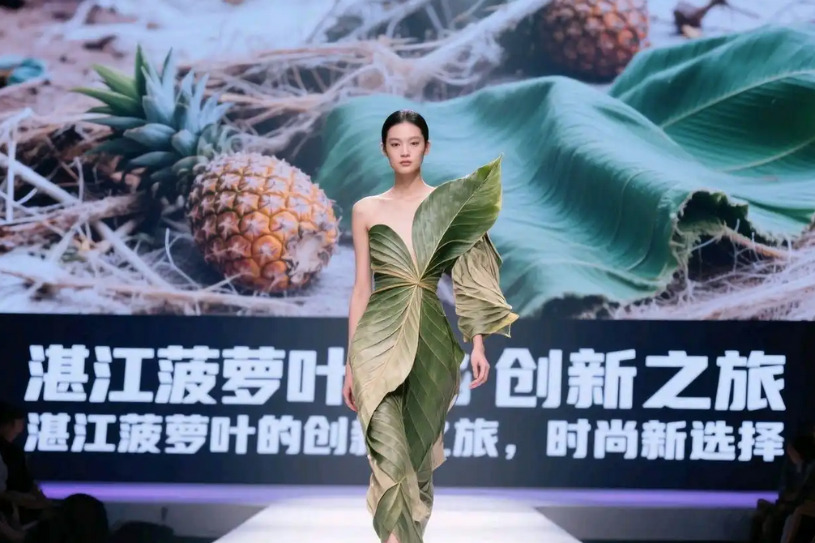A taste of China's tropics

Pineapple rice is a sweet holiday tradition that is not only simple to make, but may have health benefits
In China's vast landmass, you can find diverse cuisines from various latitudes. If you yearn for a bite of the tropics, you should definitely turn to the Dai cuisine(傣菜), which has its roots in the Dai autonomous prefecture of Xishuangbanna at the southern edge of Yunnan province. Living deep among the palm trees and rainforest, the Dai ethnic group shares strong links with Thai ethnic groups in Laos and Thailand, and their cultures have a lot in common. In China, they are known for their folk arts, brown-skinned beauties, and, perhaps above all else, their food, which features distinct spices and tastes.
Yu Nanwen is the hostess of a restaurant in Gadong village (嘎栋乡), located in Jinghong, the capital of Xishuangbanna, where Dai restaurants are concentrated. Locals flock here to experience authentic Dai cuisine.


But Yu says it is not easy to run a Dai restaurant: "Dai food is delicious but very troublesome to make. Most dishes involve many complicated steps."
So, what if amateur cooks want to try making Dai food, but do not have access to fresh spices or the time?
Yu recommends pineapple rice (菠萝饭) - essentially purple sticky rice (紫糯米) steamed in a hollowed pineapple - as a good place to start.
Yu says in her childhood the dish was cooked as a festive treat, such as during the Water-Splashing Festival (泼水节 pō shuǐ jié), or for special guests. This may have to do with the scarceness of the purple sticky rice.
The Dai ethnic people traditionally have white rice as their daily staple food instead of the purple option because the latter is produced in limited regions in Yunnan - only in Mojiang and
Xishuangbanna - and is harvested once a year.
In recent years, purple sticky rice has become better known across the country. It is largely appreciated for its flavor, but there have also been claims that it has medicinal qualities.
There is a saying in traditional Chinese medicine that "black benefits the kidneys" (黑入肾). In the abstract, unscientific style of traditional Chinese medicine, dark purple is lumped in with the color black and, therefore, food of this hue - sesame, black beans, grapes, mulberries, and the purple sticky rice - is perceived as beneficial to the kidneys.
In TCM philosophy, having feeble kidneys leads to cold limbs, dizziness and gray hair. As a result of this belief about blackish-colored foods, purple rice is recommended for women who have just given birth, the elderly, and the sick, leading to the rice's nationwide popularity.
The pineapple container is natural for Dai chefs - it is a longstanding tradition to use fresh plants as cooking containers. For example, they often have rice steamed in bamboo sections, and in a cooking method called baoshao (包烧, literally "wrap and roast"), the food is wrapped in a palm leaf and roasted on charcoal. Aside from being pleasing to the eye, it is important to integrate the fragrance and taste of the container or wrapper into the food itself. The same goes for pineapple rice.
At first glance, it may seem that the Dai pineapple rice resembles the Thai version, but there are distinct differences. The Thai pineapple rice is salty in taste, contains a variety of ingredients like shrimp, green beans and pepper and is stir-fried with oil. The Dai version, on the other hand, is sweet and sour, oil-free and consists simply of rice and pineapple. In Yu's words, "It tastes much fruitier."
To make the dish, it is ideal to have purple sticky rice and pineapples from Yunnan or Southeast Asia, which in China are referred to as "the eyeless pineapple" (无眼菠萝). But, don't worry if you can't find these ingredients. The most important thing is to remember that, on a Dai table, pineapple rice is not a staple food, just a delightful after-dinner dessert; so, be sure to make it in a festive, joyous mood.
Courtesy of The World of Chinese, www.theworldofchinese.com

Ingredients
Recipe serves 3-4 people
150 g white sticky rice 白糯米
150 g purple sticky rice 紫糯米
40 g sugar 糖
30 g raisins 葡萄干
10 g almond slices (optional) 杏仁片
1. Soak sticky rice overnight and steam it for 30 minutes. Cool and set aside. Dissolve sugar in about 100 ml of hot water. Cut off top of pineapple and save for plate decoration.
2. If steamer is tall enough, hollow pineapple by spooning out its flesh. If you have a smaller steamer, cut pineapple vertically into two halves so that they can fit into steamer.
3. The core of the pineapple is harder than the flesh and should be discarded. Carve it out with a knife. Make sure you leave a rim about 1.5 cm thick. Do not cut too close to the skin.
4. Spoon or cut out the flesh of the pineapple, creating two bowls. Again, be careful to keep the rim at about 1.5 cm thick and be sure not to poke any holes in it. Cut flesh into small cubes.
5. Mix half of chopped pineapple with sugar, raisins, almond slices and sticky rice.
6. Stuff mixture into pineapple bowls and flatten surface. Place pineapple in pot when the water starts to boil, steam for 20 minutes, and serve.
The World of Chinese
(China Daily Africa Weekly 05/22/2015 page27)
Today's Top News
- Xi congratulates Nawrocki on election as Polish president
- EU and UK should reject Trump's 'reciprocal tariffs'
- Xi receives visit from Panchen Rinpoche
- Tianwen 2 mission in good condition, 3 million km from Earth
- US emerges as biggest loser in Trump's trade war: OECD
- US visa hurdles put international students on edge






























